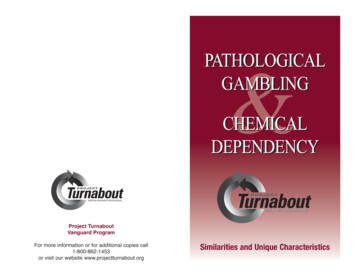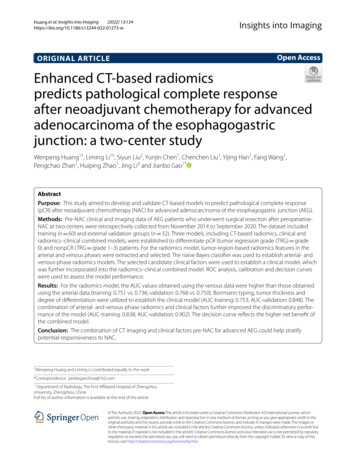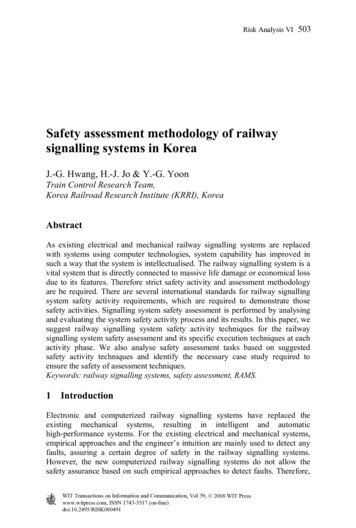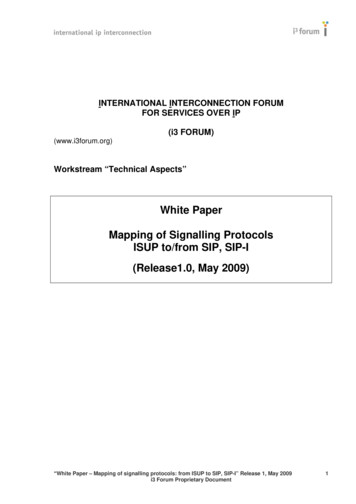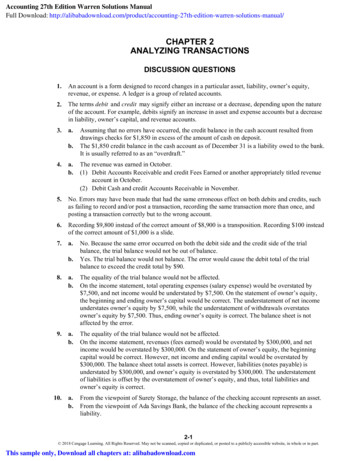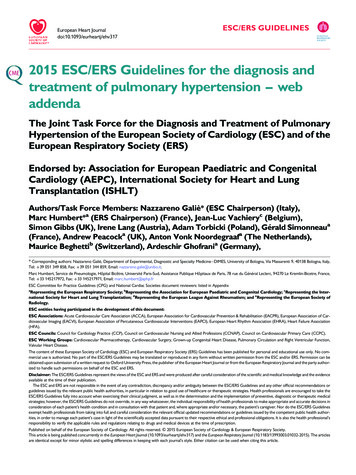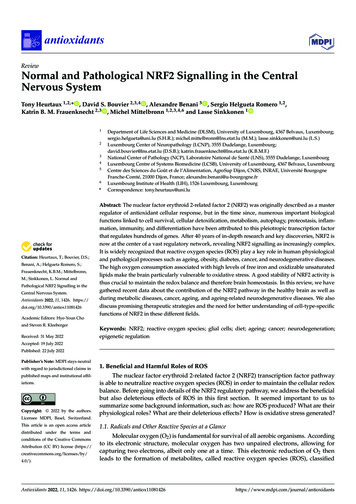
Transcription
antioxidantsReviewNormal and Pathological NRF2 Signalling in the CentralNervous SystemTony Heurtaux 1,2, * , David S. Bouvier 2,3,4 , Alexandre Benani 5 , Sergio Helgueta Romero 1,2 ,Katrin B. M. Frauenknecht 2,3 , Michel Mittelbronn 1,2,3,4,6 and Lasse Sinkkonen 1123456*Citation: Heurtaux, T.; Bouvier, D.S.;Benani, A.; Helgueta Romero, S.;Frauenknecht, K.B.M.; Mittelbronn,M.; Sinkkonen, L. Normal andPathological NRF2 Signalling in theCentral Nervous System.Antioxidants 2022, 11, 1426. https://doi.org/10.3390/antiox11081426Academic Editors: Hye-Youn Choand Steven R. KleebergerReceived: 31 May 2022Department of Life Sciences and Medicine (DLSM), University of Luxembourg, 4367 Belvaux, Luxembourg;sergio.helgueta@uni.lu (S.H.R.); michel.mittelbronn@lns.etat.lu (M.M.); lasse.sinkkonen@uni.lu (L.S.)Luxembourg Center of Neuropathology (LCNP), 3555 Dudelange, Luxembourg;david.bouvier@lns.etat.lu (D.S.B.); katrin.frauenknecht@lns.etat.lu (K.B.M.F.)National Center of Pathology (NCP), Laboratoire National de Santé (LNS), 3555 Dudelange, LuxembourgLuxembourg Centre of Systems Biomedicine (LCSB), University of Luxembourg, 4367 Belvaux, LuxembourgCentre des Sciences du Goût et de l’Alimentation, AgroSup Dijon, CNRS, INRAE, Université BourgogneFranche-Comté, 21000 Dijon, France; alexandre.benani@u-bourgogne.frLuxembourg Institute of Health (LIH), 1526 Luxembourg, LuxembourgCorrespondence: tony.heurtaux@uni.luAbstract: The nuclear factor erythroid 2-related factor 2 (NRF2) was originally described as a masterregulator of antioxidant cellular response, but in the time since, numerous important biologicalfunctions linked to cell survival, cellular detoxification, metabolism, autophagy, proteostasis, inflammation, immunity, and differentiation have been attributed to this pleiotropic transcription factorthat regulates hundreds of genes. After 40 years of in-depth research and key discoveries, NRF2 isnow at the center of a vast regulatory network, revealing NRF2 signalling as increasingly complex.It is widely recognized that reactive oxygen species (ROS) play a key role in human physiologicaland pathological processes such as ageing, obesity, diabetes, cancer, and neurodegenerative diseases.The high oxygen consumption associated with high levels of free iron and oxidizable unsaturatedlipids make the brain particularly vulnerable to oxidative stress. A good stability of NRF2 activity isthus crucial to maintain the redox balance and therefore brain homeostasis. In this review, we havegathered recent data about the contribution of the NRF2 pathway in the healthy brain as well asduring metabolic diseases, cancer, ageing, and ageing-related neurodegenerative diseases. We alsodiscuss promising therapeutic strategies and the need for better understanding of cell-type-specificfunctions of NRF2 in these different fields.Keywords: NRF2; reactive oxygen species; glial cells; diet; ageing; cancer; neurodegeneration;epigenetic regulationAccepted: 19 July 2022Published: 22 July 2022Publisher’s Note: MDPI stays neutralwith regard to jurisdictional claims inpublished maps and institutional affiliations.Copyright: 2022 by the authors.Licensee MDPI, Basel, Switzerland.This article is an open access articledistributed under the terms andconditions of the Creative CommonsAttribution (CC BY) license (https://creativecommons.org/licenses/by/4.0/).1. Beneficial and Harmful Roles of ROSThe nuclear factor erythroid 2-related factor 2 (NRF2) transcription factor pathwayis able to neutralize reactive oxygen species (ROS) in order to maintain the cellular redoxbalance. Before going into details of the NRF2 regulatory pathway, we address the beneficialbut also deleterious effects of ROS in this first section. It seemed important to us tosummarize some background information, such as: how are ROS produced? What are theirphysiological roles? What are their deleterious effects? How is oxidative stress generated?1.1. Radicals and Other Reactive Species at a GlanceMolecular oxygen (O2 ) is fundamental for survival of all aerobic organisms. Accordingto its electronic structure, molecular oxygen has two unpaired electrons, allowing forcapturing two electrons, albeit only one at a time. This electronic reduction of O2 thenleads to the formation of metabolites, called reactive oxygen species (ROS), classifiedAntioxidants 2022, 11, 1426. mdpi.com/journal/antioxidants
Antioxidants 2022, 11, 14262 of 36in radicals, including superoxide anion (O2 ), hydroxyl (HO ), alkoxyl (RO ), peroxyl(ROO ), lipid (L ), lipid alkoxyl (LO ), and lipid peroxyl (LOO ), and nonradical speciessuch as hydrogen peroxide (H2 O2 ), hypochlorous acid (HOCl), ozone (O3 ), and lipidperoxide (LOOH).Reactive oxygen species are very short-lived but reactive molecules. They are mainlyproduced at membranes of mitochondria and the endoplasmic reticulum, in peroxisomesas well as in the cytosol [1,2]. The mitochondrial respiratory chain is considered the mainsource of physiological ROS production. During respiration, around 1 to 2% of O2 isnot entirely reduced to water, therefore leading to the production of superoxide anionO2 [2,3] (Figure 1A). Furthermore, an alteration of the inner mitochondrial membranepotential and electron transport rate can lead to an increase in the production of superoxideanions. ROS can also be produced in the cytosol by a large panel of active oxidoreductasessuch as NADPH oxidases (NOX), cytochrome P450 (CYP) oxidase, cyclooxygenases (COX),lipoxygenases (LOX), and monoamine oxidases (MAO) [4,5]. The lifespan of such reactive species is rather short, as they are quickly transformed by antioxidant proteins (e.g.,superoxide dismutases (SOD), glutathione peroxidases (GPX), catalase (CAT)) into H2 O2and finally into water (Figure 1B); however, intermediate species can also be produced.Fenton and Haber–Weiss reactions, in which ferrous iron (Fe2 ) reacts with H2 O2 , cause theformation of HO , constituting one of the most reactive species. HO and hydroperoxyl(HOO ) radicals play an important role in the lipid peroxidation process by attacking lipidscontaining carbon–carbon double bonds such as polyunsaturated fatty acids [6,7] and in thesubsequent production of reactive unsaturated aldehydes (e.g., 4-hydroxynonenal (4-HNE)and malondialdehyde (MDA)) [6].Like ROS, reactive nitrogen species (RNS) are divided into radical and nonradicalspecies, including nitric oxide (NO ), nitrogen dioxide (NO2 ), peroxynitrite (ONOO ),and nitrous acid (HNO2 ). Nitric oxide is produced by the activity of nitric oxide synthases(NOS), which convert the amino acid L-arginine into L-citrulline and NO (Figure 1B). Apowerful oxidant, named peroxynitrite, is the result of the reaction between superoxideanion and nitric oxide [8]. Finally, the production of reactive species can be linked notonly to metabolic activities but also to environmental factors, such as pollutants (pesticides,heavy metals), UV radiation, and lifestyle behaviours (tobacco smoke, excess alcohol, foodhabits, unbalanced exercise) [9–12].1.2. Significance of ROSDepending on their levels, ROS can be either beneficial or harmful to living systems.Over the past thirty years, many studies highlighted that ROS, at low concentrations, areimportant mediators of numerous signalling pathways. In particular, hydrogen peroxide,the most stable ROS with a relatively long biological lifespan (cellular half-life of 10 3 s;1000 times more than other ROS), has the ability to diffuse through membranes, thus actingas an autocrine and paracrine signal [13,14]. Reactive species play useful biological roles.Indeed, ROS have been shown to be implicated in numerous physiological functions inembryonic and foetal development [15,16], neuronal development and function [17], andcellular proliferation and differentiation [18] due to notably supporting stem cell renewaland differentiation [19,20]. Roles in immune responses [21], activation of cell survivalsignalling pathways [22], normal growth and metabolism [23], tissue regeneration [24],blood pressure control [25–27], ageing prevention [28], and the execution of cell deathprograms such as apoptosis [22,29] can also be added to the long list of physiological functions attributed to ROS. Closely related to the synthesis of key signalling molecules, calledeicosanoids (leukotrienes, lipoxins, prostaglandins, thromboxanes), lipid (hydro)peroxidesare also considered as actors in normal physiological processes [6,30,31]. This eicosanoidsynthesis is linked to COX and LOX activities. Importantly, these enzymes require [31,32]low levels of pre-existing lipid hydroperoxides (LOOH) to “prime” their catalytic cycles.Eicosanoids are lipid-signalling molecules deriving from arachidonic acid. These lipidmediators are key regulators of a wide variety of physiological responses as well as patho-
Antioxidants 2022, 11, 14263 of 36logical processes. Many important cellular actions (e.g., proliferation, metabolism, andmigration) are controlled by eicosanoids in the whole body [33–35]. An imbalance of thismajor lipid-signalling pathway contribute to disease progression [36]. It should also benoted that in the absence of ROS, alteration of the previously described functions will lead todecreased cell growth, metabolism, and proliferation as well as defective host defences [23].Figure 1. Reactive species production and disruption of the redox homeostasis. (A) Generation ofsuperoxide anions (O2 ) by the complexes I and III of the mitochondrial respiratory chain. (B) ROSare byproducts of the normal metabolism of oxygen. (1) ROS formation follows the monoelectronicreduction of O2 . (2) Superoxide dismutases catalyse the dismutation of superoxide into hydrogenperoxide H2 O2 . (3) Hydroxyl radical HO is produced by decomposition of H2 O2 via the Fentonreaction (Fe(II)-dependent reaction). (4) Glutathione peroxidase catalyses the reduction of hydrogenperoxide to water via oxidation of reduced glutathione (GSH) into its disulphide form (GSSG).(5) Catalase reacts with the hydrogen peroxide to catalyse the formation of water and O2 . (6) Theproduction of nitric oxide (NO ), a reactive nitrogen species, is carried out from L-arginine bynitric oxide synthases. (7) Peroxynitrite ONOO is produced by the reaction of the free radicalsuperoxide O2 with the free radical nitric oxide NO . (8) Hypochlorous acid (HOCl) is producedthrough myeloperoxidase (MPO)-catalysed peroxidation of chloride anions using H2 O2 . (9) Nitrogendioxide (NO2 ) reacts with molecular oxygen to form, under the action of UV radiation and heat,nitric oxide (NO ) and ozone (O3 ). Lipid peroxidation (10)–(12) is a chain of reactions of oxidativedegradation of lipids: (10) unsaturated lipid (LH) reacts with prooxidants (hydroxyl radical, HO ),leading to the formation of lipid radical (L ) and water; (11) lipid radical then reacts with oxygento form a lipid peroxy radical (LOO ), which abstracts one hydrogen from another lipid molecule,generating a new lipid radical (L ) and lipid hydroperoxide (LOOH) (12). (C) The redox balance is anequilibrium between ROS production, due to pro-oxidant conditions, and antioxidant defences. Adisruption of this redox balance in favour of oxidative conditions will promote an oxidative stress.CAT, catalase; CoQ, coenzyme Q; Cyt C, cytochrome C; GPx, glutathione peroxidase; GR, glutathionereductase; GSH, reduced glutathione; GSSG, oxidized glutathione; SOD, superoxide dismutases;Trx, thioredoxin.
Antioxidants 2022, 11, 14264 of 36Upon increased ROS levels, mammalian cells, equipped with a complex antioxidantdefence system, will first try to maintain the redox balance [4,37,38]. For this purpose,enzymatic antioxidants (e.g., SOD, CAT, GPX), non-enzymatic scavengers (e.g., glutathione(GSH), thioredoxin, ascorbic acid (vitamin C), α-tocopherol (vitamin E), carotenoids), andalso enzymes that repair cell damage (e.g., polymerases, nucleases, proteases) have a fundamental role in cellular protection. Redox balance, also called redox homeostasis, is anequilibrium between the production of ROS and these different detoxification systems(Figure 1C). However, an excessive and permanent increase in ROS production will induce an oxidative stress, which is classically defined as the alteration of the intracellularredox balance in favour of oxidative conditions. When ROS generation exceeds cellularcapacity for detoxification, oxidative damage to nucleic acids (strand breaks, base oxidation), proteins (oxidation, nitration, carbonylation), lipids (peroxidation), membranes, andorganelles (altered structures and properties) can occur, leading to cell dysfunction andcell death. Ageing and many human diseases such as cancer, diabetes, neurodegenerativedisorders, cardiovascular diseases, and inflammation-related diseases have been linked tothis progressive physiological dysfunction.1.3. Redox Homeostasis in AgeingAccording to the World Health Organization (WHO), the worldwide populationover 60 years old will almost double, reaching 22% of the total population, by 2050. Theproportion of people 80 years old or older is expected to triple between 2020 and 2050.Ageing is a decline in physiological functions leading to the progressive loss of functionin tissues and organs over time [39,40]. In 1956, the chemist Denham Harman publishedthe “Free Radicals Theory of Ageing” [41]. He postulated that free radicals play a role inthe ageing process. Although this hypothesis has been questioned many times, the fact thathealthy ageing may be linked to oxidative stress resistance appears to still be relevant. Theexact mechanism of oxidative-stress-induced ageing is still not clearly defined. However,it has been well established and accepted by the scientific community that a disruptedantioxidant/oxidant equilibrium coupled with an accumulation of oxidative damage tocellular constituents (DNA, proteins, lipids) and a chronic inflammation are pervasivefeatures of ageing [42,43]. Key inflammatory players are indeed involved in the age-relatedprocess: activation of the pro-inflammatory nuclear factor kappa-light-chain-enhancer ofactivated B cells (NF-κB) pathway, upregulation of cytokines (interleukin 1 beta (IL-1β),IL-6, tumour necrosis factor alpha (TNF-α)), C-C motif chemokine ligands (CCL2, CCL20)and their receptors, and other proinflammatory factors (matrix metalloproteinases, COX2,and NOS2) [42,44–48]. All these pro-inflammatory actors are indeed more expressed inaged than in young tissues [44,49]. The antioxidant/oxidant equilibrium is then disruptedduring ageing, mainly due to a decrease in GSH synthesis as well as a downregulationof antioxidant enzymes [50,51]. A persistent oxidative stress associated with chronicinflammation may trigger ageing processes but also lead to age-related chronic diseases.2. The NRF2-KEAP1 (Kelch-Like ECH-Associated Protein 1)-ARE (AntioxidantResponse Element) Signalling Pathway2.1. Mode of RegulationAs discussed in the previous section, the control of ROS levels is crucial to maintaincellular homeostasis. NRF2 is a transcription factor that emerged as a master regulator ofthe cellular antioxidant response.Encoded by the NFE2L2 gene, NRF2 is a CNC-bZIP (Cap’n’Collar basic-region leucinezipper) transcription factor ubiquitously expressed in the body. Under normal conditions,NRF2 is kept in the cytoplasm by the KEAP1/CUL3-RBX1 E3 ubiquitin ligase complex,which is known to be the major repressor of NRF2 [52] (Figure 2). Beyond KEAP1, otherregulators also exist. Indeed, BTB and CNC homology transcription factors, called BACH1and BACH2, function as NRF2 repressors by competing with NRF2 binding to the AREsequences [53–56]. BACH1 has been described to be widely expressed in mammalian
Antioxidants 2022, 11, 14265 of 36tissues [54], whereas BACH2 is predominantly expressed in B and T lymphocytes, T cells,macrophages, and neural cells [57–59].Figure 2. NRF2-KEAP1 signalling pathway in basal conditions. Under homeostatic conditions,NRF2 is sequestered by cytoplasmic KEAP1/CUL3-RBX1 E3 ubiquitin ligase complex and targetedto proteasomal degradation. CUL3, Cullin-3; KEAP1, Kelch-like ECH-associated protein 1; NRF2,nuclear factor erythroid 2-related factor 2; RBX1, RING Box Protein 1; Ub, Ubiquitin.Sequestered in the cytosol, NRF2 is inactive and rapidly subjected to ubiquitinationand proteasomal degradation (Figure 2). NRF2 is a protein with high turn-over. Complexedwith KEAP1, the NRF2 half-life (t1/2 ) is approximately 20 min [60]. Oxidative conditions,following exposure to reactive chemicals, chemopreventive molecules (electrophiles agents),or an oxidative stress, will lead to the modification of two cysteine residues (C273 and C288)localized in the intervening region of KEAP1. As a consequence, the KEAP1-NRF2 complexwill be disrupted, and NRF2 will be released (Figure 3). Several works have confirmedthe role of such cysteine residues: mutations on cysteine 273 or cysteine 288 inactivateKEAP1 and promote the release of NRF2 [61–63]. Once free, stabilized NRF2 translocatesinto the nucleus, heterodimerizes with small musculoaponeurotic fibrosarcoma (sMAF)proteins, and binds to specific DNA sequences called antioxidant or electrophile responseelements (ARE/EpRE, 50 -TGACNNNGC-30 ) located in the 50 -flanking regions of genepromoters (Figure 3).
Antioxidants 2022, 11, 14266 of 36Figure 3. Activation and regulation of the NRF2 signalling pathway. Under stress conditions,NRF2 is released from KEAP1 and translocates to the nucleus, where it interacts with cofactors andbinds specific response elements (ARE) to regulate the transcription of its many target genes. ARE,Antioxidant Response Element; ATG5, Autophagy-related 5; BACH1/2, BTB and CNC homology1/2; BCL2, B-cell lymphoma 2; BCRP, Breast cancer resistance protein; BRCA1, Breast cancer type 1;CAT, Catalase; CYP, Cytochrome p450; DPP3, Dipeptidyl peptidase 3; FTH1, Ferritin Heavy Chain 1;FTL, Ferritin light chain; FPN1, Ferroportin1; G6PD, Glucose-6-phosphate dehydrogenase; GCLC,Glutamate-cysteine ligase catalytic subunit; GCLM, Glutamate-cysteine ligase regulatory subunit;GPX2/8, Glutathione peroxidase 2/8; GSR, glutathione reductase; GST, glutathione S-transferase;HMOX1, Heme Oxygenase 1; IDH1, isocitrate dehydrogenase 1; MAO-A, monoamine oxidase A; ME1,malic enzyme 1; MRP1, Multidrug resistance protein 1; NQO1, NAD(P)H:quinone oxidoreductase 1;NF-κB, Nuclear factor kappa-light-chain-enhancer of activated B cells; p21, cyclin-dependent kinaseinhibitor 1; p62, sequestosome 1; PALB2, Partner and localizer of BRCA2; PGAM5, Phosphoglyceratemutase 5; PGD, 6-phosphogluconate dehydrogenase; ROS, Reactive oxygen species; sMAF, smallmusculoaponeurotic fibrosarcoma; SOD, Superoxide dismutase; THXR, Thioredoxin reductase; UGT,UDP-glucuronosyltransferase; WTX, Wilms tumour gene on the X chromosome.Post-translational modifications may also regulate NRF2 activities independently ofKEAP1 expression [64]. Thus, the mitogen-activated protein (MAP) kinases, extracellular signal-regulated protein kinase (ERK) and c-jun N-terminal kinase (JNK), but alsoserine/threonine kinase (Akt), phosphatidylinositol 3-kinase (PI3K), 50 -AMP-activatedprotein kinase (AMPK), and protein kinase C (PKC) are able to phosphorylate the threonine, tyrosine and serine residues of NRF2, enhancing its activity [65–69]. In contrast,the glycogen synthase kinase-3 beta (GSK-3β) functions as an NRF2 inhibitor [70,71].KEAP1 can also be subject to modifications by phosphorylation. Huo and collaboratorsdescribed that the epidermal growth factor receptor (EGFR) tyrosine kinase was able toactivate the NRF2 signalling pathway by phosphorylating KEAP1, thus resulting in nuclearNRF2 stabilization [72].2.2. Biological FunctionsNRF2 positively regulates hundreds of genes containing ARE sequences in theirpromoter regions [73]. The key well-known NRF2 function is linked to the maintenanceof the redox balance through the synthesis or the use of γ-glutamyl-cysteinyl-glycinetripeptide (GSH). Thus, NRF2 is implicated in the de novo synthesis of GSH by the increasein glutamate-cysteine ligase (GCL) expression, the transformation of oxidized glutathione(GSSG) in GSH (glutathione reductase, GR), the expression of several enzymes using GSH
Antioxidants 2022, 11, 14267 of 36for reducing peroxides (GPXs; peroxiredoxins), the breakdown of peroxides (CAT), and theimport of cysteine (xCT transporter) important for GSH production (Figure 3).NRF2 is also involved in the upregulation of the expression of drug/xenobioticmetabolizing enzymes. Phase I and II drug-metabolizing enzymes play important detoxification roles by transforming the “parent drugs” into metabolites, which are less lipophilicand easier to eliminate through urine. NRF2 also modulates the transcription of Phase IIIdrug-metabolizing enzymes implicated in the excretion of drugs/xenobiotics and metabolites from the cell. This will lead to a decrease in the therapeutic efficacy of drugs throughtheir metabolism as well as through their elimination.Numerous papers have also described the role of NRF2 in the reprogramming ofcellular metabolism to support antioxidant responses [74,75]. Indeed, ARE sequences havebeen identified in genes implicated in glucose metabolism (glycolysis, pentose phosphatepathway, nucleotide biosynthesis pathway), lipid metabolism (lipid export, import, andsynthesis), and heme and iron metabolism due to degrading free heme into biliverdin, CO,and Fe2 (heme oxygenase 1, HMOX1), storing iron in its oxidized state (ferritin heavy chain1, FTH1; ferritin light chain, FTL), and exporting unstable iron (ferroportin 1, FPN1) [53,76].Autophagy processes and proteasome assembly are also governed by NRF2 transcription factor [77,78]. Autophagy plays an important role in removing misfolded oraggregated proteins as well as clearing damaged organelles (endoplasmic reticulum, mitochondria, and peroxisomes). Under normal conditions, the autophagy adaptor protein p62binds to ubiquitylated protein aggregates in the cytoplasm before delivering them to theautophagosomes for degradation. When autophagy is disrupted, p62 accumulates in thecytoplasm and directly interacts with the NRF2-binding site on KEAP1. In this condition,the p62-KEAP1 complex is retained in the phagosomes, resulting in NRF2 stabilizationand subsequently in transcriptional activation of NRF2 target genes [79,80]. Moreover, ithas been described that ARE sequences are located on p62 promoter [53,81], indicatingthat NRF2 can also upregulate its transcriptional expression. In this way, p62 positivelyregulates NRF2 function independently of the cellular oxidative status. In contrast, aknockdown of p62 will decrease KEAP1 degradation and therefore NRF2 activation [82,83].NRF2 levels vary significantly depending on physiological and pathological context.In recent years, many methods have been developed to monitor these changes in NRF2pathway activity (Table 1), the aim being to assess NRF2 involvement in the pathogenesis ofhuman diseases, to track disease progression but also to improve preclinical identificationof targets, chemicals, and drugs.Table 1. Methods for NRF2 activity servationsRefsInteractionKEAP1-NRF2The complexNRF2-KEAP1 issequestered in thecytosol before beingrapidly ubiquitinatedand degradated by theproteasome.Fluorescence LifetimeImaging–FörsterResonance EnergyTransfer (FLIM-FRET)approach in cellsexpressingfluorescently taggedNRF2 and KEAP1evaluation ofconformation changes inKEAP1-NRF2 complex incells/establishment ofNRF2 activation kineticsConformational changes(spatial distribution) canresult in functionalinactivation of thecomplex andconsequential inductionof an NRF2-mediatedstress response.[84–86]Western blotsevaluation of the NRF2localisation (cytoplasmicversus nuclear levels)increase in NRF2 level inthe nucleus[87–89]NRF2translocationFree NRF2 will enter inthe nucleus andactivate thetranscription of NRF2target genes.immunofluorescence(cells, tissues)NRF2 staining in thenucleusincrease in NRF2 level inthe nucleus[87,90]transcriptomic analysesanalyses of NRF2 targetgenes expressionincrease in geneexpression[53,87,91]
Antioxidants 2022, 11, 14268 of 36Table 1. Cont.ActivitiesNRF2 binding toAREsGSH productionDescriptionFree NRF2 enters in thenucleus and binds tospecific sequences(Antioxidant ResponseElements, ARE). Thisbinding will activatethe transcription ofgenes that have AREsequences on theirpromoter.NRF2 regulates GSHbiosynthesizingenzymes (GCLM,GCLC) and plays a keyrole in the regulation ofcellular GSHhomeostasisMethodsPrincipleObservationsRefsARE luciferasereporter kitCells are transfected byan ARE luciferasereporter vectorconstitutively expressingRenilla luciferase vector.Amount of lightgenerated aftertreatments is positivelycorrelated with the AREluciferase reporteractivity as a consequenceof NRF2 binding toARE sequence.[92]ElectrophoreticMobility Shift Assay(EMSA)Nuclear extracts areincubated with an NRF2probe (oligonucleotidecontaining the AREconsensus sequence).Protein/DNA complexesare separated on anondenaturingpolyacrylamide gel andtransferred to amembrane. Detection isperformed usingStreptavidin-HRPConjugate and achemiluminescentsubstrate.The shifted bandscorresponding to theprotein/DNA complexes(interaction of NRF2 withits ARE-probe)are visualized.[93]DNA-binding ELISAfor activated NRF2transcription factorNRF2 transcription factor(from nuclear extracts)binds to DNA sequence(containing the NRF2consensus binding site)immobilized in the well.Incubation with primaryand secondary antibodiesspecifically quantifies theamount of activatedtranscription factor.This method is 100-foldmore sensitive thanEMSAs. Colorimetricreadout enables easy,quantitative analysis byspectrophotometryat 450 nm.[94]NRF2/ARE luciferasereporter stable cell linesAfter treatments, theNRF2 transcription factorwill enter in the nucleusand bind to its responseelement. As aconsequence, luciferase isexpressed, and light willbe generated in anenzymatic assay(addition of luciferin).Amount of lightgenerated is positivelycorrelated with the levelof NRF2 activation.[95]high-content imagingof cell lines expressingfluorescent-taggedNRF2 (fluorescentprotein reporter celllines, expressing GFPtagged Nfe2l2)High-throughput liveconfocal imaging is usedto measure the temporaldynamics of the NRF2pathway after treatments.Fluorescent protein signalintensity is correlated toNRF2 response.[96]GSH quantification(GSH assay kit)GSH is oxidized by thesulfhydryl reagent 5,5’dithio-bis(2-nitrobenzoicacid). The formedderivative is measurableat 412 nm. Theglutathione disulphide(GSSG) formed can berecycled to GSH byglutathione reductase inthe presence of NADPH.Increase in the GSHlevels may confirm NRF2recruitment. Glutathionequantification can beperformed in anybiological fluids, tissues,and cell extracts.[97]
Antioxidants 2022, 11, 14269 of 36Table 1. sPrincipleObservationsRefstransgenic mousemodelsTransgenic NRF2 / mice (NRF2 pathway isdownregulated) orKEAP1 / mice (NRF2pathway is upregulated)can be useful in order toverify the implication ofthe NRF2 pathwayduring pathologiesor ageing.Transgenic animalmodels are commerciallyavailable.[98,99]OKD48 transgenic miceThe OKD48 construct hasa 3xARE promoter,human Nfe2l2, andFlag-tagged luciferase.Upon stress, OKD48 istranscriptionally inducedby the 3xARE element,and luciferase activity(luminescence) isobserved only in cellsexperiencingoxidative stress.OKD48-luc model is ahighly specific andsensitive system forscreening NRF2 activity[100,101]activation/inhibition ofthe NRF2 signallingpathway and inactiveluciferase-taggedNfe2l2, can be set up intransgenic mousemodels3. Oxidative Stress, Inflammation, and NRF2 in the Brain3.1. The Brain, an Ideal Target for Oxidative AttacksThe brain is particularly vulnerable to oxidative stress. To support intensive neuronalactivity, the brain consumes almost 20% of the total O2 intake. This high O2 consumptionassociated with a high content of free metals (e.g., iron, copper, zinc, manganese), oxidizable polyunsaturated fatty acids, and auto-oxidation of neurotransmitters (dopamine,norepinephrine, and serotonin) may increase the risk of producing excessive ROS and, asa result, will make the brain vulnerable to ROS-mediated injury [102,103]. Compared toother organs (liver, kidney), the brain has fewer antioxidant defences, with lower CAT, GPX,and SOD activities. As an example, CAT concentration in the brain is 50 times lower thanin the liver [104]. Disparities also exist within the brain itself. Unlike neurons, astrocytesand microglia appear to contain high GSH levels [105]. Neuronal GSH level is at least50% lower than in other cells [103]. The major antioxidant scavenger, GSH, which is aγ-glutamyl-cysteinyl-glycine tripeptide, is important for cellular defence against reactiveoxygen/nitrogen species. In the presence of reactive species, two molecules of GSH areoxidized to one molecule of GSSG, which is afterwards reduced to GSH by glutathionereductase. Astrocytes can convert glutamate released by neurons into glutamine and γglutamyl-cysteine, two GSH precursors. Since neuronal GSH levels are modest, astrocytesprovide precursors (glutamine, cysteinyl-glycine dipeptide) to neurons to produce GSHthemselves [106] to efficiently degrade H2 O2 . In addition to GSH release, astrocytes havealso been described to produce other antioxidant molecules (e.g., ascorbate and vitamin E)and to activate ROS-detoxifying enzymes to protect neurons [105]. During oxidative insults,both astrocytes and microglia focus on maintaining the brain homeostasis in order to protectneurons. However, a huge production of reactive species as well as a GSH deficiency willcontribute to a severe oxidative stress and will then play a role in the o
habits, unbalanced exercise) [9-12]. 1.2. Significance of ROS Depending on their levels, ROS can be either beneficial or harmful to living systems. Over the past thirty years, many studies highlighted that ROS, at low concentrations, are important mediators of numerous signalling pathways. In particular, hydrogen peroxide,

